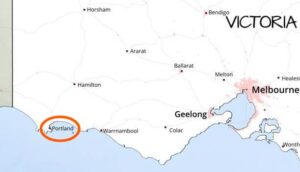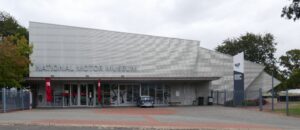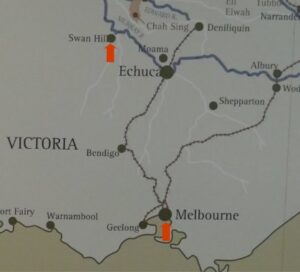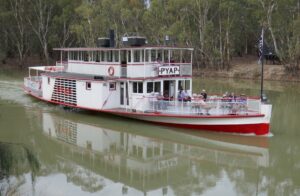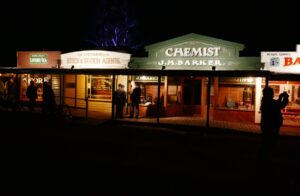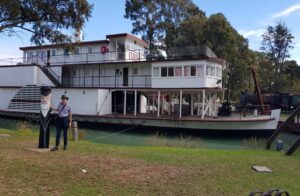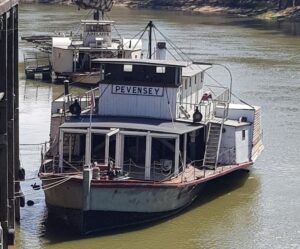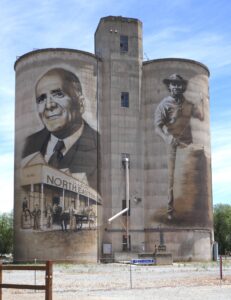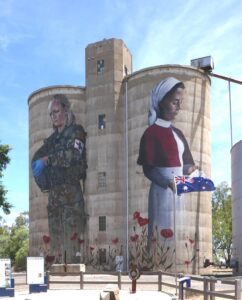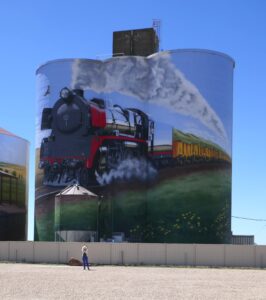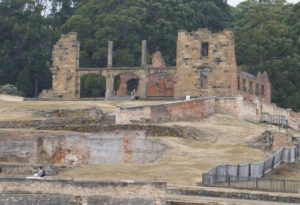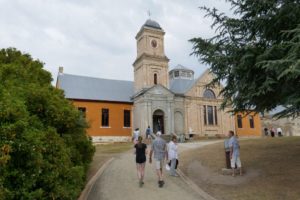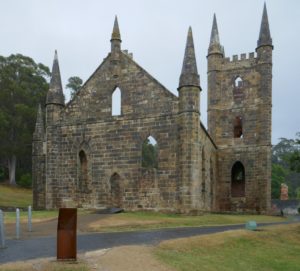Finally I’m back on a cruise ship!I tend to book cruises as soon as they go on sale, so at when Covid first surfaced I had three booked. After multiple cruise cancellations and rebooks over the last three years, 2023 begins with three cruises in ten weeks. My first post-Covid (or should this be ‘Covid-era’?) cruise on the Grand Princess and my longest (13 nights, 5 sea days) so far, was from Melbourne, round New Zealand and home again. Here’s a quick summary: I won’t try and give a detailed guide to each place since lots of other people have done this already. Apart from Napier, I didn’t take any of the ship tours, choosing to do my own thing. FiordlandAfter two sea days we reached Fiordland at the far south west of NZ’s South Island. Several cruise ships have recently been refused entry to these waters because of hull contamination issues; fortunately we were fine. The highlight of the day (arguably of the cruise) was the early morning cruise around Milford Sound, nominated by Rudyard Kipling as his eighth wonder of the world. The weather was perfect; friends who have been to the Sound experienced rain and fog. Then on to Doubtful Sound and Dusky Sound before sailing for Port Chalmers, the nearest port to Dunedin. Port Chalmers (Dunedin)At Port Chalmers I stepped onto foreign soil for the first time since my mid-2019 UK trip. A NZ$35 (return) shuttle bus ran from the dock into Dunedin, conveniently (for me), stopping near the railway station. The station is a spectacular building, unfortunately half-shrouded in scaffolding when we were there. Then up to the Octagon at the heart of the city, St Paul’s Cathedral, Otago Museum, then back to the Toitu Settlers Museum, before getting the shuttle back to the ship. Lyttleton (Christchurch)The overnight sail took us to Lyttleton, the port for Christchurch, 12km away. Another NZ$35 shuttle. Christchurch has been, sadly, totally reshaped by the 2010 and 2011 earthquakes which killed 185 people and destroyed thousands of buildings, including the iconic cathedral spire. After walking round the city centre I went on to the Quake Museum where I spent a couple of hours taking in the horror that Christchurch residents lived through (and still do to a degree). Then a walk through the Botanic Gardens and past the Arts Centre buildings to get the shuttle back to the ship. At Christchurch my one and only credit card stopped being accepted by card readers which left me with a just small amount of cash – I know to be better prepared next time! WellingtonOn to North Island. Our third port day, Sunday Jan 15th, was spent in Wellington, New Zealand’s capital. The shuttle bus was free this time. Yet another beautiful sunny day. Before it got too hot I climbed to the Mount Victoria lookout (196m) with its stunning views over the city then back down to the Te Papa Museum of New Zealand. The Gallipoli gallery reminded me of the huge sacrifices made by NZ troops in WW1. In total I walked more than 22,500 steps. NapierAnother, day, another port: Napier. This was the only place where I took a ship tour, and I am glad I did: an hour’s coach tour followed by a visit to the Art Deco Centre then an excellent guided walk around the city centre. On the morning of 3 February 1931 Napier city centre was destroyed by a massive earthquake and ensuing fires. Within a few years it was largely rebuilt and now has one of the world’s greatest concentrations of Art Deco buildings. After the walk we were left to explore on our own. The seafront with its beautiful floral displays brought back memories of happy childhood seaside holidays. TaurangaPort five, Mount Maunganui/Tauranga, was a bit different: no sightseeing, rather a chance to meet up with friends of 40+ years, who emigrated to NZ in 1996. Tugs pulled us off the quay: large ships aren’t allowed to use bow thrusters as they could damage the quays. Soon after departure the captain made a somewhat opaque announcement re increasing respiratory infections (carefully not using the ‘C’ word), warned us that the programme might need to be changed, and reiterated that we were required (not requested) to wear masks in public areas except when eating and drinking. AucklandLast stop before sailing home. Just six hours in Auckland, New Zealand’s largest city: we had to sail at 1500 so as to leave the harbour clear for commuter ferries. I enjoyed more sunshine walking round the city centre, finishing up at the New Zealand Maritime Museum. Nine days later Auckland experienced unprecedented rain and massive floods. The unexpectedThe voyage back from Auckland to Melbourne took three full sea days. It was a little choppy along the way which upset my system – so sad not to be able to enjoy all the good food on offer. Not on the schedule was a helicopter medivac on the last full day. The helicopter was at the end of its range so after dropping two paramedics had to return to the mainland to refuel, then returning to the ship to collect the paramedics and patient. Hopefully he/she has made a full recovery and had travel insurance. Life on boardWith the veiled Covid warnings I decided to play safe and gave most of the mass entertainment a miss. I did though go to the sea day Bible studies – it’s left to those attending to decide how these are run and the ones on this voyage were not as good as some I’ve engaged in previously. What gave me particular joy was listening to the recitals given by the Amethyst Duo, two young women from Ukraine, Varvara (piano) and Valeriia (violin). For them, a world away from home in more senses than one. The pre-destination lectures given by tour manager Sue Beard were truly excellent. I had a Club Class cabin so ate in a reserved area of the Da Vinci dining room. My waiters Rommel and Nishi were outstanding. Across the board, the crew members I met could be not be faulted. In summary, since I was a solo travelled and opted for a mini-suite it wasn’t a cheap cruise, but for me the experience more than justified the cost. But currently two people sharing an interior cabin can do an identical 12-night cruise for just A$1198 (~£700) – cheaper than staying in a cheap hotel and that’s before you factor in meals, entertainment etc. Now to 2023 cruise number two! * * * |
 Cruise map (from Princess Cruises)  Grand Princess 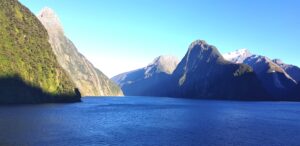 Milford Sound  Milford Sound 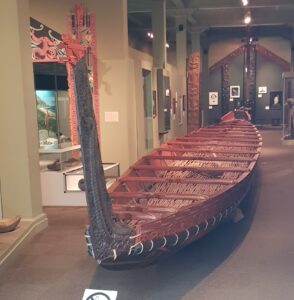 Maori canoe, Toitu Museum, Dunedin 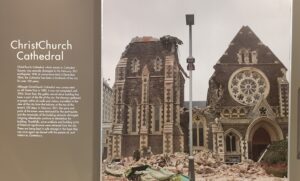 Picture of Christchurch Cathedral after the earthquake  One of the Christchurch Arts Centre buildings  View over Wellington from Mount Victoria  Te Papa Museum, Wellington  Art Deco Centre, Napier 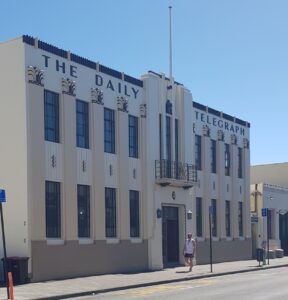 Daily Telegraph building, Napier  Making a new friend in Tauranga 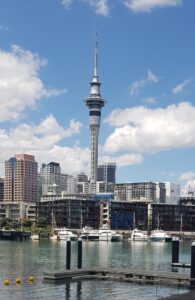 Auckland  Auckland Ferry Terminal, 1912 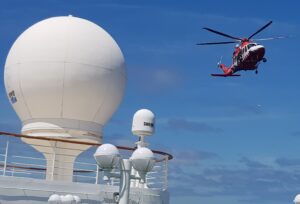 The sight you don’t want to see 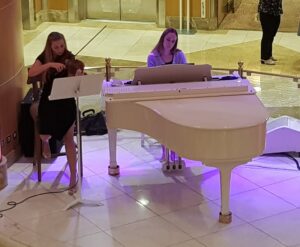 Beautiful music from the Amethyst Duo  Home! |
